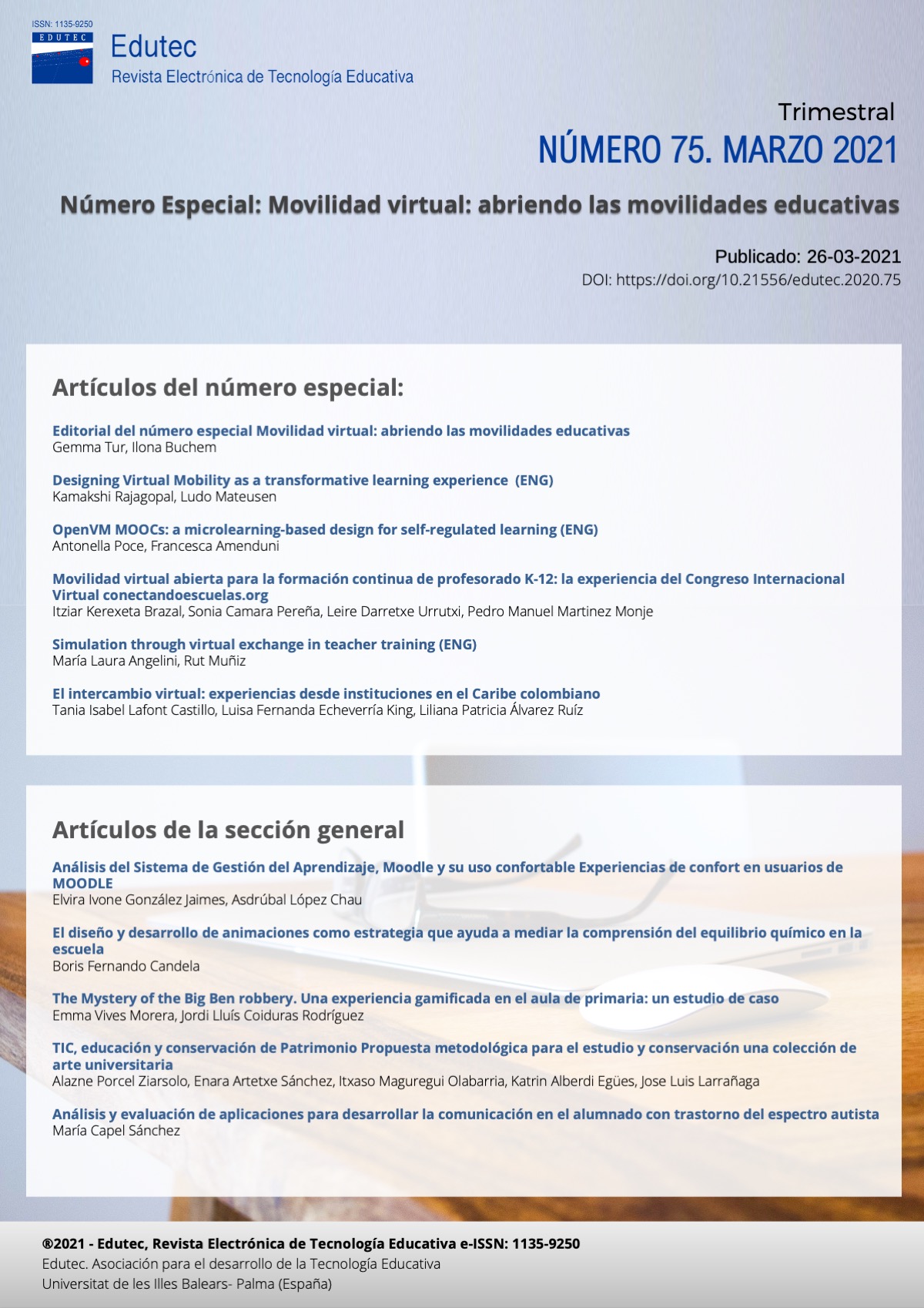Open Virtual Mobility for K - 12 Teacher Training: the experience of the International Virtual Congress conectandoescuelas.org
DOI:
https://doi.org/10.21556/edutec.2021.75.1895Keywords:
open virtual mobility, universal accessibility, international virtual congress, K-12 teacher trainingAbstract
This article presents the review of the virtual mobility experience of the International Virtual Congress connecting schools, held on 6, 7 and 8 May 2019 with a group of 411 attendees from 8 countries in Latin America and Spain working on compulsory education (K-12) and universal accessibility and inclusion in school.
The virtual format was chosen following open virtual mobility criteria as a guarantee of inclusion. Free registration was chosen to ensure economic accessibility, the virtual format to facilitate international contact and the possibility of participation for educational agents from rural communities, and the clear commitment to multiple literacies, offering audio, Spanish Sign Language and Visual Thinking simultaneously
An analysis of the impact and dissemination achieved, the accompaniment of the organisational and honorary committees, as well as the responses to the satisfaction survey carried out on the people who participated in the congress, led us to the conclusion that this format is very collaborative and accessible, also creating a high impact in the generation of a virtual network where common knowledge can be shared.
Downloads
References
Alonso, F. (2007). Algo más que suprimir barreras: conceptos y argumentos para una accesibilidad universal. TRANS: revista de traductología, 11, 15-30. https://doi.org/10.24310/TRANS.2007.v0i11.3095 DOI: https://doi.org/10.5944/ried.21.2.20666
Buchem, I., Konert, J., Carlino, C., Casanova, G., Rajagopal, K., Firssova, O., y Andone, D. (2018). Designing a Collaborative Learning Hub for Virtual Mobility Skills - Insights from the European Project Open Virtual Mobility. En P. Zaphiris & A. Ioannou (eds.), Learning and Collaboration Technologies (pp.350-375). Springer. DOI: https://doi.org/10.22201/iisue.24486167e.2017.156.58285
Borgman, C. L., Leazer, G. H., Gilliland-Swetland, A. J., y Gazan, R. (2001). Iterative design and evaluation of a geographic digital library for university students: A case study of the Alexandria Digital Earth Prototype (ADEPT). En P. Constantopoulos & I.T. Sølvberg (eds.), Research and Advanced Technology for Digital Libraries (pp. 390-401). Springer. DOI: https://doi.org/10.23913/ride.v10i20.677
Cabero, J. (2006). Comunidades virtuales para el aprendizaje. Su utilización en la enseñanza. Edutec. Revista Electrónica de Tecnología Educativa, 20, a053. https://doi.org/10.21556/edutec.2006.20.510 DOI: https://doi.org/10.7821/naer.2015.7.123
Deardoff, D. (2006). Identification and Assessment of Intercultural Competence as a Student Outcome of Internationalization. Journal of Studies in International Education, 10 (3), 241-266. https://doi.org/10.1177/1028315306287002 DOI: https://doi.org/10.14201/eks.23448
Duart, J. M., y Martínez, M. J. (2001). Evaluación de la calidad docente en entornos virtuales de aprendizaje. Cuadernos IRC. http://reddigital.cnice.mec.es/6/Documentos/docs/articulo12_material.pdf
Eurydice Report. (2015). La profesión docente en Europa. Publications Office.
Garcia-Aretio, L., Álvarez-González, B., y Ruiz-Corbella, M. (2008). NetACTIVE: bases y propuestas para las buenas prácticas en movilidad virtual (Un enfoque intercontinental) DOI: https://doi.org/10.3390/educsci11050211
García-Peñalvo, F. J., y Seoane Pardo, A. M. (2015). Una revisión actualizada del concepto de eLearning. Décimo Aniversario. Education in the Knowledge society, 16(1), 119-144. https://doi.org/10.14201/eks2015161119144 DOI: https://doi.org/10.33225/pec/21.79.397
Hjorth, L. (2006). Being mobile: In between the real and reel. In Asian Pop and Mobile Cultures conference, Gwangju (Vol. 28, p. 29). DOI: https://doi.org/10.3390/educsci9040299
Gómez, L., y Silas, J. (2016). La comunidad virtual de práctica. Alternativa para la formación continua de profesores. CPU-E, Revista De Investigación Educativa, p. 28-51. http://ref.scielo.org/bphks8 DOI: https://doi.org/10.18634/sophiaj.13v.1i.364
Harasim, L., Roxanne, S., Turoff, M., y Teles, L. (2000). Redes de aprendizaje: guía para la enseñanza y el aprendizaje en red España. Gedisa. DOI: https://doi.org/10.23919/CISTI49556.2020.9141011
Illanas, A., y Llorens, F. (2011). Los retos Web 2.0 de cara al EEES. RUA. http://hdl.handle.net/10045/19766 DOI: https://doi.org/10.33255/2957/357
Kahiigi Kigozi, E., Ekenberg, L., Hansson, H., Tusubira, F. F., y Danielson, M. (2008). Exploring the e-learning state of art. Electronic Journal of E-Learning, 6(2), 77-88. http://urn.kb.se/resolve?urn=urn:nbn:se:su:diva-18592 DOI: https://doi.org/10.15517/aie.v18i3.34211
Lave, J., y Wenger, E. (1991). Situated learning: Legitimate peripheral participation. Cambridge university press. DOI: https://doi.org/10.14483/22487638.16934
Leask, B. (2009). Using Formal and Informal Curricula to Improve Interactions between Home and International Students. Journal of Studies in International Education, 13(2), 205-221. https://doi.org/10.1177/1028315308329786 DOI: https://doi.org/10.19083/10.19083/ridu.2021.1209
Ortega, J. A. (2015) Fundamentación y estrategias tecnológico-didácticas del modelo Affective Learning aplicado a contextos inclusivos y accesibles. En L. Bengochea, C. Delia y A. Miñán (coord.), Formación virtual inclusiva y de calidad para el siglo XXI (pp. 32-34). Editorial Universidad de Granada. DOI: https://doi.org/10.1016/j.nedt.2022.105297
Pérez, M. G., y Sánchez, I. O. (2010) Atención a la e-accesibilidad y usabilidad universal en el Diseño Formativo. Pixel-Bit. Revista de Medios y Educación, 36, 89-99. https://recyt.fecyt.es/index.php/pixel/article/view/61337 DOI: https://doi.org/10.1016/j.edumed.2022.100729
Poce, A., Amenduni, F., Re, M., y De Medio, C. (2020). Assessing a MOOC users experience in a virtual mobility project: preliminary results for quality enhancement. Italian Journal of Educational Technology, 28(1), 62-76. https://doi.org/10.17471/2499-4324/1126
Ruiz Corbella, M., García Aretio, L., Álvarez González, B., y Rubio Gómez, M. J. (2011). Movilidad virtual en másteres a distancia en Europa y América Latina. Un camino por recorrer. Revista Iberoamericana De Educación, 55, 225-242. https://rieoei.org/RIE/article/view/533
Saavedra, L. E. P., & Cervera, M. G. (2020). Desafíos para las universidades colombianas frente a políticas nacionales e internacionales de integración de TIC en la educación. Edutec. Revista Electrónica de Tecnología Educativa, (73), 51-65. DOI: https://doi.org/10.5209/RCED.53520
Souza, M. S., Migliorati, M. A., Vidarte Asorey, V., Vestfrid, P., Palazzolo, F. y Otrocki, L. (2009). De congresos presenciales a congresos virtuales. http://sedici.unlp.edu.ar/bitstream/handle/10915/26807/Documento_completo.PDF?sequence=1&isAllowed=y
Torres, R. M. (2006). Derecho a la educación es mucho más que acceso de niños y niñas a la escuela. https://cutt.ly/fg88DcV
Vriens, M., Op de Beeck, I., y Van Petegem, W. (2013). Make it work! Integrating virtual mobility in international internships. EDULEARN13 (pp. 5521-5527). IATED. DOI: https://doi.org/10.4067/S0718-50062019000500051
Downloads
Published
How to Cite
Issue
Section
License
By submitting the paper, the authors assign the publication rights to the journal Edutec. For its part, Edutec authorises its distribution as long as its content is not altered and its origin is indicated. At the end of each article published in Edutec, the citation procedure is indicated.
The management and editorial board of Edutec Revista Electrónica de Tecnología Educativa do not accept any responsibility for the statements and ideas expressed by the authors in their work.
Translated with www.DeepL.com/Translator (free version)









